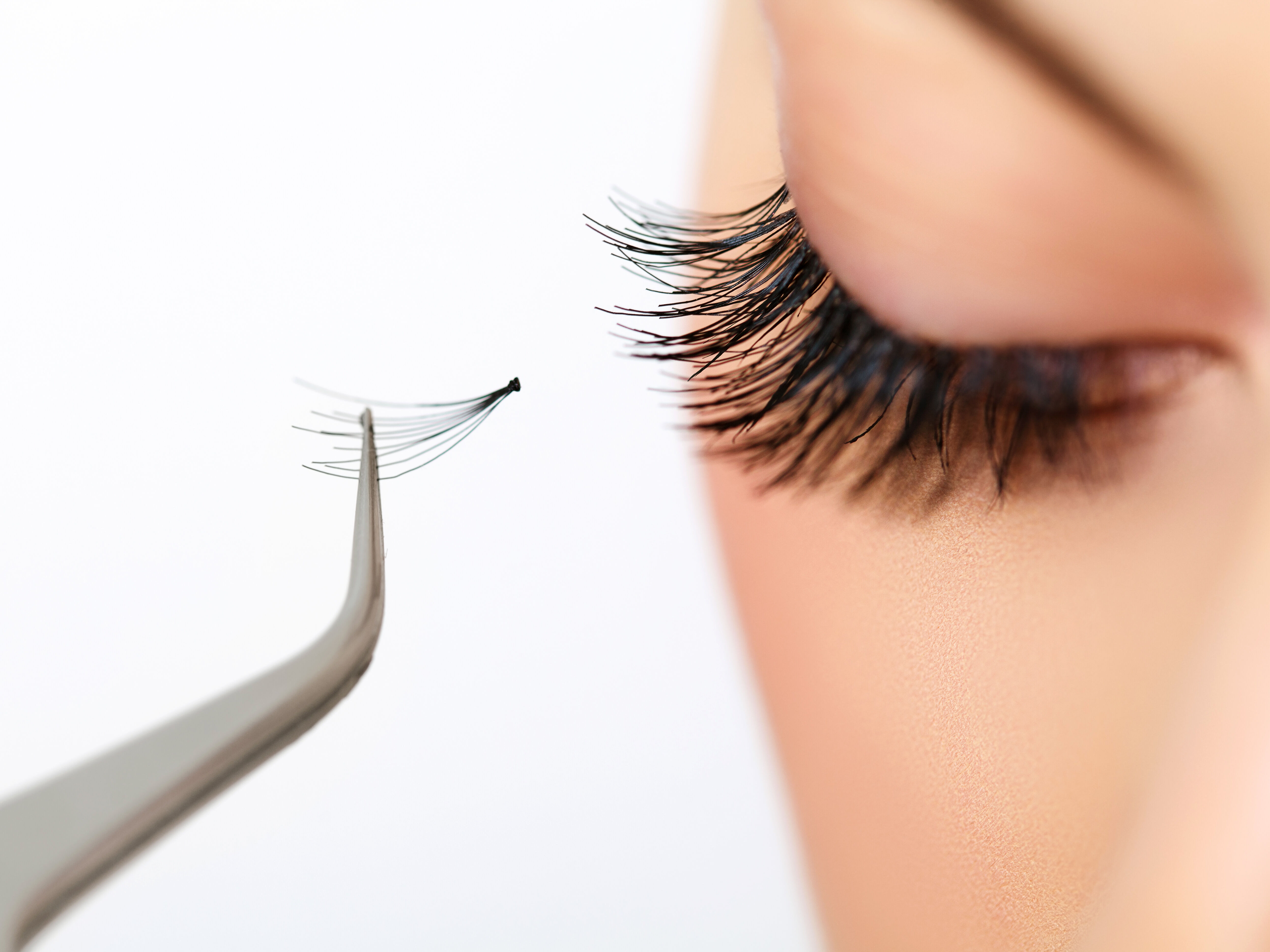Eyelid contact dermatitis
- February 3, 2022
- by NATALIYA KUSHNIR
- Articles
What is eyelid contact dermatitis?

Inflammation of the eyelids due to contact with irritant chemical is called eyelid contact dermatitis. This is a chronic condition once sensitization to the certain chemical occurred. While it might be just a mild itching and redness first time (irritant eyelid dermatitis), every time after that first reaction the next will have more involvement (allergic contact dermatitis).
Contact dermatitis of the eyelids is very common, as there are plenty of chemicals used in preparation of the cosmetic products and objects that are used often and for a prolonged period of time on the eyelids:
- Eyeliner
- Eye shades
- Creams and lotions
- Artificial eyelashes
- Eyelash synthetic implants
- Eyelash growth factors
- Mascara
- Makeup removers
- Artificial tears
- Medicated eye creams

An allergic eyelid contact dermatitis is a delayed reaction – symptoms do not happen right away and actually tend to wait for 24-72 hours! This makes it so difficult to figure out. It takes sometimes months to figure out the culprit even to the experienced allergist or dermatologist. Why? Because, in addition to the obvious irritants, there are plenty of hidden dangers that are brought to the eyes by our hands. Indeed, we tend to touch the eyelids countless during the day. So, any chemical we touch in our environment can be left on the eyelids after we rub the eyes.
For example, someone who is cleaning the surface with irritating bleach is likely to develop eye irritation. The first response will be to rub the eye with the hand that is all covered with the cleaning solution. A bleach itself is an irritant and can cause immediate burning and itching. But there are several other chemicals (more in the cheap products). A reaction on the eyelid that develops some hours later to one of the sensitizing chemicals is unlikely to be traced by the person to the event that happened earlier.

Allergic and irritant contact dermatitis of the eyelids can be very disturbing and affect the quality of life significantly. Why is that? Because the skin around the eyes is very sensitive, and eyes are a visible part of the body (which add an emotional factor). Also, vision can be affected if the swollen eyelids cannot open wide enough. While there are several symptom relieving treatments, still the only cure is to find out what cosmetic or household chemical caused it and to completely avoid it.
There are several ways to find out what is that compound you need to avoid. You can try a detective work yourself, but if you are clueless it is best to see an allergist who can offer you a specific test and will provide a clear guidance how not to get that rash again.
Irritant eyelid contact dermatitis

Irritant eyelid contact dermatitis is a term for a milder form of the same disease. If the reaction happened to a chemical irritant in nature, and did not come back, it is likely to be called irritant. While in some people irritating chemicals will cause just redness and itching, other people will develop full clinical picture of the inflammatory reaction. This might also have a genetic predisposition making some people more sensitive.
How does irritant eyelid contact dermatitis occur?
Irritant or abrasive chemicals and solutions usually have a warning about their nature. If something like acetone or bleach gets on the skin, it damages the skin (epodermis and dermal inner layer). An inflammatory reaction that happens immediately is also called a chemical burn. Later such reaction might heal completely or create a scar if the damage was substantial.
What triggers irritant eyelid contact dermatitis?
As we discussed before – there are plenty of chemicals that can be causing the eyelid rash. Anything from eyeliner to the shampoo may be responsible for the rash on the eyelids. As a matter of fact, many organic cometic product lines may contain an ingredient causing your rash. The list if possible, contact irritants is endless.
It really depends on the nature of the chemical, quality of the skin and how prolonged was the contact.
Who gets irritant eyelid contact dermatitis?
While anyone can get the irritant eyelid contact dermatitis, workers of certain professions tend to get it more often:
- House maids and janitors
- Woodworkers
- Textile workers
- Painters
- Chemists
- Car mechanics
- Jewelers

How is the diagnosis of irritant eyelid contact dermatitis made?
Usually, it is not hard to figure out what caused the red irritational reaction. A good history of exposure and a clinical examination allows a specialist to set the diagnosis right. Other possible reasons (such as infection, trauma, allergic reaction must be excluded in difficult cases).
Allergic eyelid contact dermatitis
Allergic eyelids contact dermatitis is a term that is used in chronic rashes that come and go, that are a delayed immune reaction to the chemical or an ingredient of the product used.
How does allergic eyelid contact dermatitis occur?
Allergic contact dermatitis is a reaction of the immune cells to a specific molecule of a substrate, which can be a metal, a cleaning product ingredient, a part of cosmetic or beauty product coming in a prolonged and tight contact with the skin.
Indeed, while the skin is normal it has a very good protection from the outside elements. Our dermal layers are tight and are covered with the epidermis – an outer durable and impermeable to most liquids we use and touch. There are several unfortunate events that must come together for the chemical to get inside the skin (dermis) and penetrate to the inner layer where the immune cells reside. Here are the factors that lead to contact dermatitis:
- Defective protective quality of the skin (dryness, scratches, genetical problem with skin cell junctions)
- A particular chemical is from the list of substances capable of triggering contact dermatitis
- A chemical is in a tight contact with the skin
- The contact with the skin is prolonged (usually more than 12 hours).
What triggers allergic eyelid contact dermatitis?
Same chemicals that cause an irritant dermatitis can cause an allergic immune reaction of the body. Unfortunately, once contact dermatitis started, it tends to have an “innocent bystander effect”. What that means is any next chemical that touches the area of the immune reaction can become a sensitizer. So, people who have the rash for a long time usually become sensitive to multiple products including treatment creams prescribed to help with inflammation.
Who gets allergic eyelid contact dermatitis?
A genetic of familial predisposition does exist. It can run in families and can affect all children or only some. Some people never get contact dermatitis, while others are very sensitive and tend to have reaction to many products. There is no age limit when the reaction can happen first time. There is also no prediction if that will get better overtime.
How is the diagnosis of allergic eyelid contact dermatitis made?

Allergic contact dermatitis has a certain clinical picture and history. An experienced specialist will try to rule out other causes of rash first (many rashes look similar to food allergy reaction or environmental allergy). After the exam, a test for contact sensitivity might be necessary to determine a specific chemical that causes the rash on the eyelids. Such test is called Patch test – a strip with tiny wells containing various known chemicals is taped to the back for 24 hours. Then a nurse or a doctor examines the positive skin reactions and compares to the numbers to the existing list of chemical’s names. Sometimes, a special patch strip can be made to test the suspicious personal makeup products.
What is the treatment for eyelid contact dermatitis?
There are many steroidal creams (prescription and over-the-counter) that are used for treatment of the contact dermatitis. The difficulty is an application of the creams on the eyelids. Most of these creams will irritate the eye if getting inside the eyelids. We recommend to find the agent that caused the trouble in the first place and completely avoid any product that contains it. While the eyelids are recovering it is important to keep the skin moist. The natural oils are the best – you can use organic olive oil or even avocado oil. Plain Vaseline can be used, but it is very thick and may interfere with blinking.

